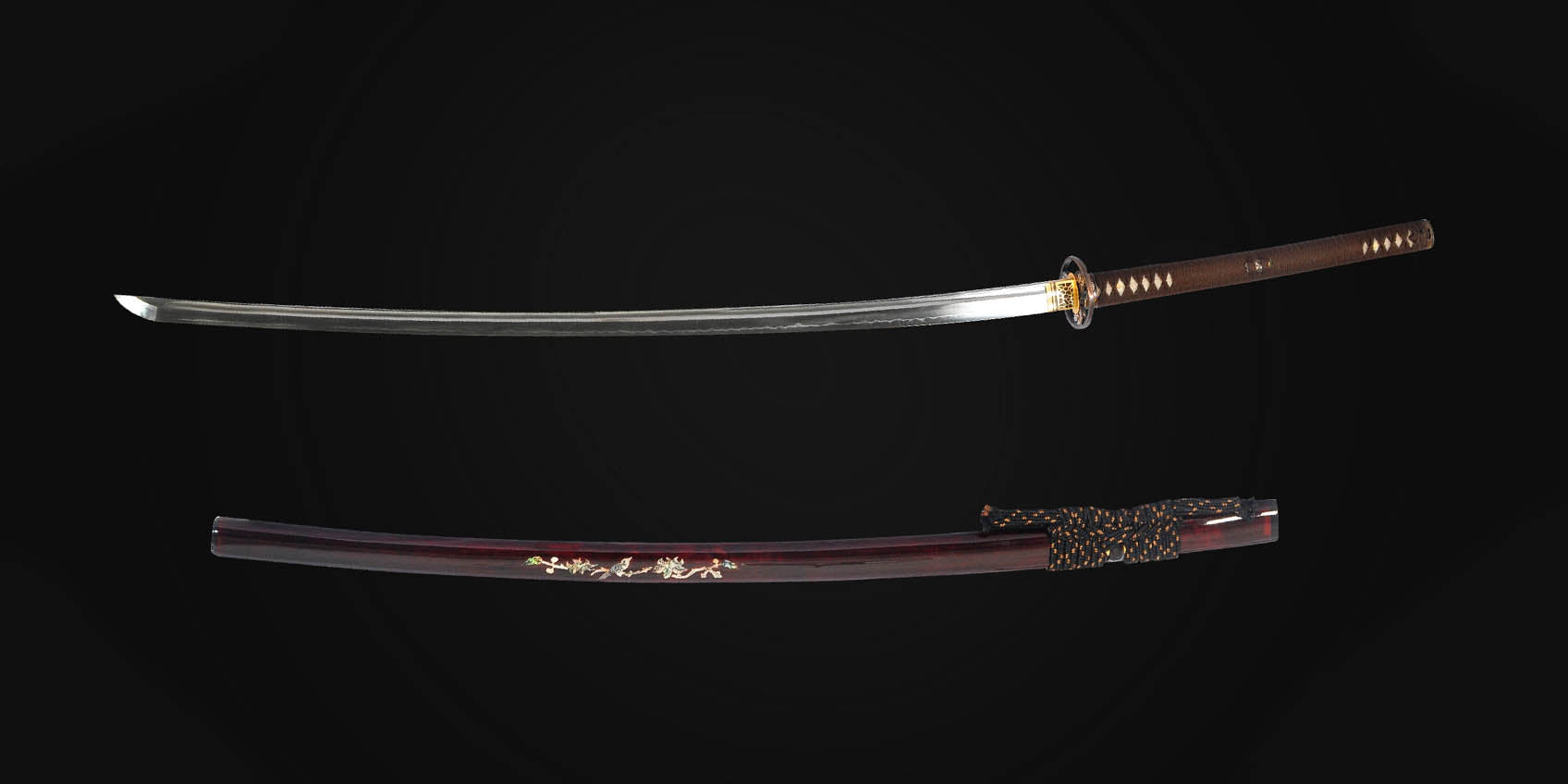ดาบซามูไรโอดาจิที่ตีขึ้นมือราคาเท่าไหร่? คู่มือราคา

ในบรรดาดาบซามูไรญี่ปุ่นแบบดั้งเดิม ดาบโอดาจิ โดดเด่นด้วยขนาดมหึมาและรูปลักษณ์อันสง่างาม ดาบ โอดาจิตีขึ้นมือเล่ม นี้ประดิษฐ์ขึ้นโดยใช้เทคนิค การตีดินเหนียว แบบดั้งเดิม โดดเด่นด้วย ซึบะทองแดงลายมังกร และ ซายะลายเปลือกหอย อันประณีต ดาบตีขึ้นด้วยเทคนิค ฮอนซันไม (เหล็กสามชั้น) อันคลาสสิก ผสมผสานการใช้งานและคุณค่าทางศิลปะเข้าด้วยกันอย่างลงตัว เหมาะสำหรับทั้งนักสะสมและผู้ฝึกฝนการตีดาบแบบดั้งเดิม
โอดาจิเป็นดาบจริงหรือเปล่า?
ใช่แล้ว โอดาจิ (大太刀) คือดาบญี่ปุ่นแบบดั้งเดิมอย่างแท้จริง มีต้นกำเนิดในยุคเซ็นโกคุ เป็นอาวุธที่ยาวและหนักกว่า คาตานะ ทั่วไปอย่างเห็นได้ชัด ออกแบบมาเพื่อใช้ในสนามรบโดยเฉพาะ โดยเฉพาะการต่อสู้กับทหารม้าหรือในพื้นที่โล่ง นอกจากการใช้งานจริงแล้ว โอดาจิยังเป็นสัญลักษณ์ของอำนาจและสถานะของซามูไรอีกด้วย ด้วยขนาดและการใช้งานที่ไม่สะดวก จึงถูกแทนที่ด้วยดาบอเนกประสงค์ที่ใช้งานได้หลากหลายกว่า แต่ยังคงเป็นสัญลักษณ์สำคัญในประวัติศาสตร์และวัฒนธรรมญี่ปุ่น
1. ภูมิหลังทางประวัติศาสตร์และความสำคัญทางวัฒนธรรมของโอดาจิ
ดาบโอดาจิ หรือที่รู้จักกันในชื่อ โนดาจิ เป็นดาบญี่ปุ่นแบบดั้งเดิมที่มีความยาวใบดาบโดยทั่วไปมากกว่า 90 ซม. (35 นิ้ว) บางครั้งอาจยาวกว่า 120 ซม. (47 นิ้ว) ซึ่งใหญ่กว่า ดาบคาตานะ ทั่วไปมาก ใน ช่วงยุคเซ็นโกกุ (ศตวรรษที่ 15 ถึง 17) ดาบโอดาจิมีบทบาทสำคัญในการรบในสนามรบ ระยะการเอื้อมและคมตัดที่ทรงพลังทำให้มีประสิทธิภาพในการรบในที่โล่งและใช้ในการขับไล่ทหารม้า
โอดาจิเป็นมากกว่าอาวุธ — มันคือ สัญลักษณ์อันทรงพลังที่แสดงถึงยศฐาบรรดาศักดิ์และฝีมือการต่อสู้ของซามูไร การครอบครองดาบเช่นนี้สะท้อนถึงสถานะนักรบชั้นยอดและพละกำลังอันโดดเด่น การปรากฏตัวของดาบอันน่าเกรงขามในสนามรบมักสร้างความกลัวให้กับคู่ต่อสู้ นายพลและนักรบซามูไรผู้มีชื่อเสียงหลายคนเป็นที่รู้จักในการใช้ดาบโอดาจิ ซึ่งมรดกของพวกเขาเชื่อมโยงกับดาบอันทรงพลังนี้ไปตลอดกาล
การถกเถียงกันอย่างต่อเนื่องเกี่ยวกับ “โอดาจิ vs คาตานะ” เน้นย้ำถึงความแตกต่างสำคัญๆ ทั้งในด้านโครงสร้าง การใช้งาน และความหมายทางวัฒนธรรม โอดาจิมีระยะการถือที่ไกลและพลังทำลายล้างสูง จึงเหมาะอย่างยิ่งสำหรับการต่อสู้ขนาดใหญ่ ในขณะที่ คาตานะ มีน้ำหนักเบาและคล่องตัวกว่า จึงเหมาะกับการต่อสู้ระยะประชิดและการพกพาในชีวิตประจำวันมากกว่า
เมื่อญี่ปุ่นเข้าสู่ ยุคเอโดะ ที่สงบสุขมากขึ้น โอดาจิก็เริ่มไม่ได้รับความนิยมอีกต่อไปเนื่องจากมีขนาดใหญ่และพกพายาก ดาบ คาตานะ และ วากิซาชิจึงค่อยๆ ถูกแทนที่ด้วยดาบคาตานะและวากิซาชิ ที่ควบคุมได้ง่ายกว่า ซึ่งเหมาะกับยุคสมัยใหม่มากกว่า ความต้องการดาบก็เปลี่ยนไปสู่การผสมผสานระหว่างประโยชน์ใช้สอยและความสวยงาม ทำให้โอดาจิกลายเป็นของใช้ในพิธีกรรมและของสะสมมากขึ้น
ในพิธีกรรมดั้งเดิมของญี่ปุ่น ดาบโอดาจิยังคงรักษาสถานะเชิงสัญลักษณ์เอาไว้ ดาบเหล่านี้มักถูกนำไปแสดงในพิธีกรรมและเทศกาลต่างๆ เพื่อแสดงถึง อำนาจ เกียรติยศ และประเพณีการต่อสู้ ด้วยขนาดที่ใหญ่โตและฝีมืออันประณีตบรรจง ทำให้ดาบเหล่านี้เป็น งานศิลปะ อันทรงคุณค่าที่นักสะสมและผู้ที่ชื่นชอบต่างแสวงหา
ขนาดของโนดาจิ เป็นความท้าทายสำคัญสำหรับช่างตีดาบ การสร้างโอดาจิคุณภาพสูงต้องอาศัยทักษะอันยอดเยี่ยม ตั้งแต่การเลือกใช้เหล็กที่เหมาะสม การพับซ้ำๆ และการตีดินเหนียวอย่างแม่นยำ เป้าหมายคือการทำให้ได้ความแข็งแรงและความยืดหยุ่น พร้อมกับรักษาความคมกริบไว้
โอดาจิ คือสุดยอดแห่งการออกแบบดาบญี่ปุ่นแบบดั้งเดิม อาวุธทรงพลังที่ใช้ในสนามรบ สัญลักษณ์ทางวัฒนธรรม และงานศิลปะอันทรงคุณค่า โอดาจิสะท้อนจิตวิญญาณแห่ง บูชิโด วิถีชีวิตของซามูไร ปัจจุบัน โอดาจิยังคงดึงดูดนักสะสมดาบและผู้ที่ชื่นชอบศิลปะการต่อสู้ ด้วยรูปลักษณ์ที่โดดเด่น ประวัติศาสตร์อันเป็นตำนาน และความสำคัญอันลึกซึ้งในมรดกทางวัฒนธรรมญี่ปุ่น
II. เทคนิคการตีเหล็ก: การผสมผสานที่ลงตัวระหว่างเหล็กกล้าคาร์บอน 1095 และการอบชุบดินเหนียวโทสะ
ดาบโอดาจิ เล่มนี้สร้างขึ้นจาก เหล็กกล้าคาร์บอนสูง 1095 คุณภาพพรีเมียม ผ่านการตีขึ้นรูปหลายชั้นเพื่อให้ได้ใบดาบที่ทั้งทนทานและยืดหยุ่น โครงสร้างนี้ช่วยให้ใบดาบยังคงสภาพสมบูรณ์และไม่แตกร้าวแม้ภายใต้แรงกระแทกที่รุนแรง ด้วยปริมาณคาร์บอนสูง เหล็ก 1095 จึงมีความแข็งและความคมที่โดดเด่น จึงเป็นหนึ่งในวัสดุที่ได้รับการยอมรับอย่างสูงในวงการตีดาบญี่ปุ่นแบบดั้งเดิม
ที่สำคัญยิ่งกว่านั้น โอดาจิรุ่นนี้ใช้เทคนิค การตีเหล็กด้วยดินเหนียวโทสะ แบบดั้งเดิมของญี่ปุ่น ซึ่งเป็นกระบวนการอบชุบด้วยความร้อนที่พิถีพิถันและมีเอกลักษณ์เฉพาะตัว ในระหว่างการตีเหล็ก ช่างฝีมือจะทาส่วนผสมดินเหนียวสูตรพิเศษที่อุดมไปด้วยแร่ธาตุและสารยึดติดลงบนผิวใบมีด การเคลือบดินเหนียวจะบางลงตามขอบเพื่อเพิ่มความแข็ง และหนาขึ้นที่สันใบมีดเพื่อรักษาความยืดหยุ่นและความเหนียว
ในกระบวนการชุบแข็งขั้นต่อไป ใบดาบจะถูกทำให้เย็นลงอย่างรวดเร็ว ด้วยความหนาและองค์ประกอบของดินเหนียวที่แตกต่างกัน คมมีดจึงแข็งตัวเป็นชั้นเหล็กที่คมกริบ เผยให้เห็นลวดลาย ฮามอน (เส้นเทมเปอร์) ที่เป็นลอน แบบคลาสสิก ขณะที่สันดาบยังคงนุ่มและยืดหยุ่นมากขึ้นเนื่องจากการเย็นตัวที่ช้าลง การผสมผสานระหว่างความแข็งและความยืดหยุ่นนี้ไม่เพียงแต่ช่วยเพิ่มความทนทานและความต้านทานต่อการแตกหักของดาบเท่านั้น แต่ยังช่วยเพิ่มความสวยงามอีกด้วย
นอกจากนี้ ใบมีดยังผลิตขึ้นโดยใช้วิธีการ Honsanmai (โครงสร้างเหล็กสามชั้น) ซึ่งช่วยเพิ่มประสิทธิภาพให้ดียิ่งขึ้น เทคนิคนี้ประกอบด้วยการประกบแกนเหล็กอ่อนไว้ระหว่างชั้นนอกที่แข็งกว่าสองชั้น เพื่อให้ได้ความสมดุลระหว่างความแข็งแกร่งและความยืดหยุ่นอย่างลงตัว ด้วยเหตุนี้ มีดโอดาจิเล่มนี้จึงไม่เพียงแต่สามารถรองรับการใช้งานจริงในการต่อสู้เท่านั้น แต่ยังมีคุณสมบัติต้านทานการกัดกร่อนและโครงสร้างที่มั่นคงเป็นเลิศอีกด้วย
วิธี การตีดาบด้วยดินเหนียวโทสะ มีต้นกำเนิดจากภูมิภาคโทสะของญี่ปุ่น และถือเป็นหนึ่งในแก่นแท้ของการทำดาบญี่ปุ่นแบบดั้งเดิม ไม่ใช่แค่กระบวนการทางเทคนิคเท่านั้น แต่ยังเป็นการแสดงออกทางศิลปะที่สะท้อนถึงความมุ่งมั่นของช่างตีดาบในด้านคุณภาพและการเคารพในประเพณี ลายฮามอนและดินเหนียวอันประณีตบนใบมีดไม่เพียงแต่ใช้งานได้จริงเท่านั้น แต่ยังเป็นเครื่องบ่งชี้ที่สำคัญถึงความแท้จริงและคุณภาพของงานฝีมืออีกด้วย
โดยสรุปแล้ว โอดาจินี้ถือเป็นสุดยอดแห่งศิลปะการตีเหล็กแบบดั้งเดิม ผ่านการผสมผสานอันยอดเยี่ยมของเหล็กกล้าคาร์บอน 1095 และการอบชุบดินเหนียวโทสะ ดาบเล่มนี้เปี่ยมไปด้วยความแข็งแกร่ง ความยืดหยุ่น และศิลปะภาพ เปรียบเสมือน ดาบคาตานะที่ใช้งานได้ จริงอย่างยอดเยี่ยม และเป็นผลงานช่างฝีมือดั้งเดิมของญี่ปุ่นที่น่าสะสมอย่างยิ่ง
III. การวิเคราะห์มูลค่าตลาด: อะไรเป็นตัวกำหนดราคาของ Odachi?
เมื่อพิจารณาว่า ดาบซามูไรโดยเฉพาะดาบโอดาจิมีมูลค่าเท่าไร จะ มีปัจจัยสำคัญหลายประการที่ส่งผลต่อราคาสุดท้าย ดังนี้
-
คุณภาพวัสดุ : เหล็กกล้าคาร์บอนเกรด 1095 และโครงสร้าง Honsanmai ช่วยเพิ่มประสิทธิภาพอย่างมากและทำให้ราคาสูงขึ้น
-
เทคนิคการตี : ดาบที่ตีขึ้นด้วยมือทั้งหมด โดยเฉพาะดาบที่ใช้กรรมวิธีอบชุบแบบดั้งเดิม มีมูลค่าสูงกว่ามาก
-
อุปกรณ์ดาบ : องค์ประกอบตกแต่ง เช่น ซึบะทองแดง และ ซายะ (ฝักดาบ) ที่มีลายเปลือกหอย เพิ่มความสวยงามและมูลค่าสะสม
-
ขนาดดาบ : เนื่องจากมีขนาดใหญ่กว่าและมีฝีมือการประดิษฐ์ที่ซับซ้อนกว่า ดาบโอดาจิจึงมีราคาแพงกว่าดาบคาทานะมาตรฐานโดยทั่วไป
-
มูลค่าทางประวัติศาสตร์และงานฝีมือ : ดาบโบราณหรือดาบที่สร้างโดยช่างตีดาบที่มีชื่อเสียงอาจมีราคาสูงกว่ามาก
โดยทั่วไปแล้ว ดาบโอดาจิตีมือที่วางขาย อาจมีราคาตั้งแต่หลายพันถึงกว่าหนึ่งหมื่นดอลลาร์สหรัฐ ขึ้นอยู่กับคุณภาพและแหล่งที่มา แม้ว่าจะมี ดาบราคาถูก มากมายในตลาด แต่ดาบเหล่านี้มักขาดฝีมือและวัสดุที่จำเป็นสำหรับการใช้งานจริงหรือการสะสมในระยะยาว
ดาบโอดาจินี้ใช้วัสดุแบบดั้งเดิม โครงสร้างที่ประณีต และรูปแบบทางประวัติศาสตร์ จึงโดดเด่นทั้งในฐานะ อาวุธที่ใช้งานได้จริง และ ของสะสมอันยอดเยี่ยม ที่รวบรวมมรดกแห่งการทำดาบของญี่ปุ่น
IV. คุณค่าคู่: การใช้งานจริงและการสะสม
-
การฝึกฝนศิลปะการต่อสู้แบบดั้งเดิม :
ดาบโอดาจิตีมือ นี้เหมาะอย่างยิ่งสำหรับการฝึกฝน เทคนิคดาบซามูไร แบบดั้งเดิม ด้วยน้ำหนักที่มากและความยาวที่ยาว ช่วยให้ผู้ฝึกสามารถควบคุมพลังฟันและการประสานงานเท้าได้ดีขึ้น ทำให้พวกเขาเข้าถึงจิตวิญญาณแห่งดาบญี่ปุ่นได้อย่างเต็มที่ สำหรับผู้ที่ชื่นชอบศิลปะการต่อสู้ที่มีทักษะพื้นฐาน การฝึกฝนกับโอดาจิจะช่วยเพิ่มทั้งความแข็งแกร่งทางกายภาพและความแม่นยำทางเทคนิค มอบประสบการณ์การต่อสู้ที่สมจริงยิ่งขึ้น -
การจัดแสดงของสะสม :
โอดาจิไม่ได้เป็นเพียงอาวุธที่ใช้งานได้จริงเท่านั้น แต่ยังเป็นงานศิลปะและมรดกทางวัฒนธรรมอันทรงคุณค่า เมื่อนำมาจับคู่กับ แท่นจัดแสดงดาบคาตานะ ที่ประดิษฐ์อย่างประณีต จะเผยให้เห็นถึง ฮามอน (ลายเส้นคมกริบ) อันเป็นเอกลักษณ์ของดาบและฝีมืออันประณีต ไม่ว่าจะจัดแสดงในห้องทำงานหรือพื้นที่จัดแสดงเฉพาะ ก็ช่วยเสริมความงามแบบญี่ปุ่นดั้งเดิมอันแข็งแกร่ง และสะท้อนรสนิยมและสถานะอันสูงส่งของนักสะสม -
มรดกทางวัฒนธรรม :
ในฐานะสัญลักษณ์สำคัญของ วัฒนธรรมซามูไร ดาบโอดาจิมีความหมายทางประวัติศาสตร์และจิตวิญญาณอันลึกซึ้ง ดาบโอดาจิไม่ได้เป็นเพียงอาวุธในสนามรบเท่านั้น แต่ยังเป็นตัวแทนของอัตลักษณ์ เกียรติยศ และสำนึกในหน้าที่ของนักรบอีกด้วย นักประวัติศาสตร์ นักวิชาการด้านวัฒนธรรม และผู้ที่ชื่นชอบศิลปะพื้นบ้านต่างหลงใหลในดาบโอดาจิอย่างลึกซึ้ง โดยมักสะสมและค้นคว้าเพื่ออนุรักษ์และเชิดชูจิตวิญญาณของซามูไร -
การจัดแสดงวัฒนธรรมดาบแบบบูรณาการ :
คอลเลกชันและการจัดแสดงดาบสมัยใหม่มักจัดแสดง ดาบญี่ปุ่นหลากหลายประเภท รวมถึง ดาบทาจิ (Tachi ) อันงดงาม ดาบตรงญี่ปุ่น ที่คมกริบ และแน่นอน ดาบโอดาจิ (Odachi) อันสง่างาม การนำดาบหลากหลายรูปแบบเหล่านี้มาจัดแสดงร่วมกันไม่เพียงแต่เน้นย้ำถึงเอกลักษณ์เฉพาะตัวของดาบเท่านั้น แต่ยังสะท้อนถึงประเพณีอันหลากหลายและซับซ้อนของวัฒนธรรมดาบญี่ปุ่น สร้างบรรยากาศที่ทั้งดื่มด่ำทางวัฒนธรรมและดึงดูดสายตา -
มูลค่าตลาดและการลงทุน :
ด้วยความชื่นชมในงานฝีมือแบบดั้งเดิมและความสำคัญทางวัฒนธรรมที่เพิ่มมากขึ้น ดาบโอดาจิคุณภาพสูงจึงมีมูลค่าเพิ่มสูงขึ้นในตลาดนักสะสม ดาบตีขึ้นด้วยมือที่ประดิษฐ์ด้วย เหล็กกล้าคาร์บอน 1095 และเทคนิค การอบชุบด้วยดินเหนียวโทสะ ได้รับความนิยมอย่างมากในหมู่นักสะสมและนักลงทุน ไม่ว่าจะเป็นมรดกตกทอดของครอบครัวหรือสินทรัพย์ที่มีมูลค่าเพิ่มในระยะยาว ดาบโอดาจิก็มีศักยภาพทางการตลาดที่แข็งแกร่ง
สรุปแล้ว โอดาจิตีมือเล่ม นี้ไม่เพียงแต่ตอบโจทย์ความต้องการด้านดาบแบบดั้งเดิมเท่านั้น แต่ยังมีคุณค่าอันหาที่เปรียบไม่ได้ทั้งในด้านการสะสมและการอนุรักษ์ทางวัฒนธรรม ถือเป็นสิ่งที่ต้องมีสำหรับทั้งผู้ฝึกฝนศิลปะการต่อสู้และนักสะสมดาบผู้จริงจัง
V. เคล็ดลับและข้อควรพิจารณาในการซื้อ
-
ควรใส่ใจเป็นพิเศษกับ วัสดุ เทคนิคการตี และ รายละเอียดฝีมือ เมื่อซื้อ
-
เลือกแบรนด์ดาบที่มีชื่อเสียงหรือผู้ค้าปลีกที่น่าเชื่อถือเพื่อรับประกัน ความเป็นของแท้และคุณภาพ
-
เตรียมเครื่องมือบำรุงรักษาที่เหมาะสมเพื่อให้ใบมีดคมและยืดอายุการใช้งาน
-
หากคุณเป็นมือใหม่ ควรพิจารณาเริ่มด้วย ดาบฝึกคาทานะ หรือดาบซามูไรที่สั้นกว่าเพื่อสร้างความคุ้นเคยกับวัฒนธรรมการใช้ดาบทีละน้อย
ดาบโอดาจิที่ตีขึ้นอย่างดีนี้ไม่เพียงแต่เป็นดาบธรรมดา แต่ยังเป็นศูนย์รวมของวินัยในการต่อสู้ งานฝีมือที่มีประวัติศาสตร์ยาวนาน และมรดกอันยั่งยืนของซามูไร
ทำไมถึงเลือกโอดาจิของ COOLKATANA?
การเลือกมีดโอดาจิจาก COOLKATANA หมายถึงการรับประกันคุณภาพที่เหนือชั้นและประสบการณ์งานฝีมืออันยอดเยี่ยม COOLKATANA ยึดมั่นใน เทคนิคการตีเหล็กด้วยมือ แบบดั้งเดิม ผสมผสาน เหล็กกล้า คาร์บอนสูง 1095 เข้ากับการอบชุบดินเหนียวโทสะแบบดั้งเดิม เพื่อให้มีดโอดาจิทุกเล่มมีคมที่คมกริบและความทนทานเป็นเลิศ จึงเหมาะอย่างยิ่งสำหรับทั้งการฝึกฝนการต่อสู้และการสะสม
นอกเหนือจากประสิทธิภาพแล้ว COOLKATANA ยังใส่ใจในรายละเอียดอย่างพิถีพิถัน ตั้งแต่ ซึบะรูปมังกรทองแดง ไปจนถึง เชลล์ซายะ (ฝักดาบไม้เคลือบเงา) ที่รังสรรค์อย่างประณีต ทุกองค์ประกอบล้วนสะท้อนถึงศิลปะอันประณีตบรรจง นอกจากนี้ เรายังมี ตัวเลือกการปรับแต่ง ที่หลากหลาย เพื่อตอบสนองความต้องการของนักสะสมและผู้ฝึกฝนศิลปะการต่อสู้แต่ละท่าน
ไม่ว่าคุณจะเป็นผู้ซื้อครั้งแรกหรือผู้ที่ชื่นชอบดาบมากประสบการณ์ COOLKATANA พร้อมมอบประสบการณ์โอดาจิระดับพรีเมียม พร้อมบริการระดับมืออาชีพ คุณภาพที่เชื่อถือได้ และราคาที่เป็นธรรม การเลือก COOLKATANA คือการเคารพและมุ่งมั่นในประเพณีการประดิษฐ์ดาบญี่ปุ่น
บทสรุป
ดาบโอดาจิตีขึ้นมือ ดาบยาวญี่ปุ่นชุบดินเหนียว เปลือกซึบะทองแดง Saya Honsanmai คือผลงานชิ้นเอกที่แท้จริงที่ผสมผสานเทคนิคดั้งเดิมเข้ากับสุนทรียศาสตร์ที่ใช้งานได้จริง ดาบเล่มนี้มีความสำคัญทางประวัติศาสตร์และวัฒนธรรมอันลึกซึ้ง พร้อมทั้งมีคุณค่าอันน่าสะสม
สำหรับผู้ที่ชื่นชอบ ดาบซามูไรญี่ปุ่น อย่างแท้จริง Odachi นี้ถือเป็นการลงทุนที่คุ้มค่าและเป็นสมบัติล้ำค่าที่ควรมีไว้ในครอบครอง
หากคุณต้องการเรียนรู้เพิ่มเติมเกี่ยวกับ ดาบญี่ปุ่น ดาบซามูไร หรือดาบคลาสสิกอื่นๆ โปรดติดต่อเรา เรามีบริการปรับแต่งดาบโดยผู้เชี่ยวชาญและบริการขายดาบ เพื่อให้คุณได้ครอบครองดาบซามูไรในฝันได้อย่างง่ายดาย









